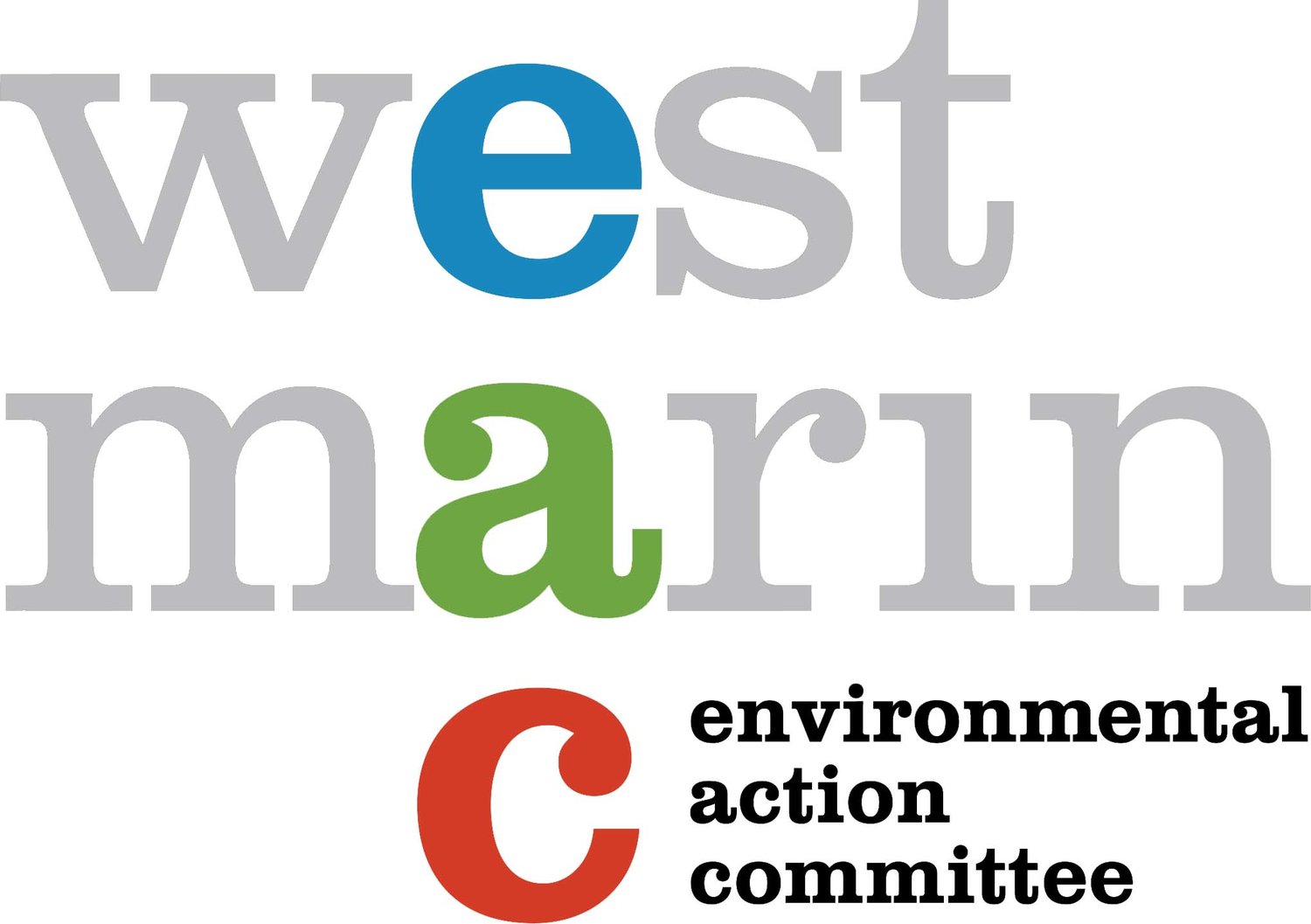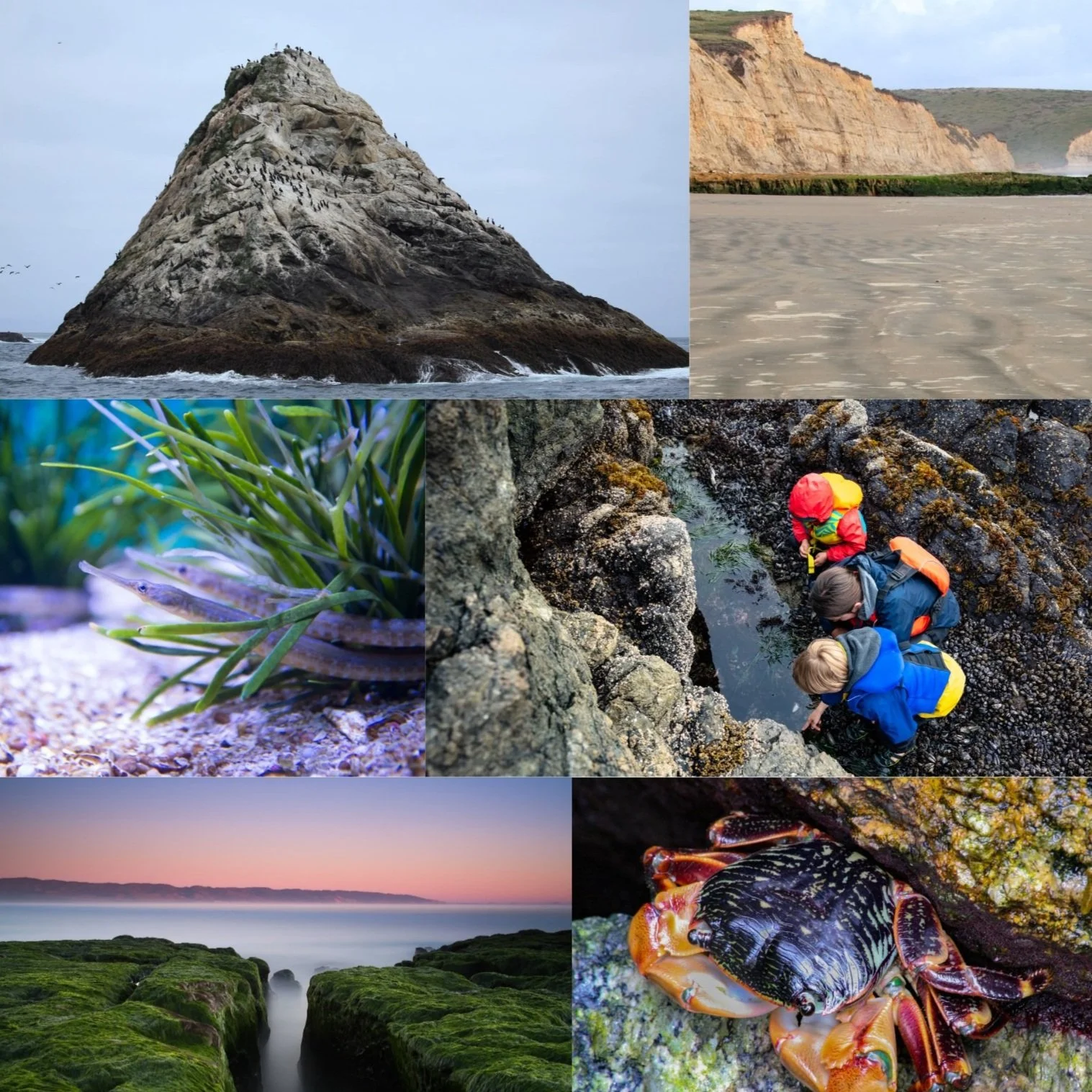Educational Exhibit: Protect our Ocean & Safeguard our Future
The Environmental Action Committee of West Marin opened environmental educational exhibit, Our Coast and Ocean: Protect the Ocean and Safeguard our Future, in Point Reyes Station on Saturday, June 25, 2022. This exhibit features information about the diverse coastal and marine ecosystems near the County of Marin
Borrow This Exhibit
Includes: 3 Educational stand-up banners (Local Golden Gate, Go play in your MPA, and Science of MPAs); 5 educational panels (18 x 24 inches) about eelgrass (2), why oceans matter, how climate change is harming our ocean, and ocean circulation; poster about national marine sanctuaries (24 x 32 inches); Greater Farallones National Marine Sanctuary banner (8 x 40 inches); posters about Duxbury Docents and Marin MPA Watch (2 EAC stewardship and coast programs, 17.5 x 23.5 inches); photographs of some local MPAs including Drakes Estero and Duxbury Reef; posters about Greater Farallones National Marine Sanctuary (NMS) (x4) and Cordell Bank NMS; posters about plastic education (x3); plastic beach art (1); one poster about coastal blue carbon; poster about ocean acidification and marine debris; and posters about birds ingesting plastic. Many of the items are suitable for wall hanging and are either foam core type, framed, or laminated.
Email info@eacmarin.org.
Inspired by the natural beauty and diverse marine life found along coastal Marin County, the exhibit highlights how protections like the network of California Marine Protected Areas (MPAs) and the Greater Farallones and Cordell Bank National Marine Sanctuaries support biodiversity, protect coastal and marine habitats, and safeguard the ocean for current and future generations.
California’s coastal ocean waters are among the most biologically productive in the world. These marine resources are vital to the state’s coastal economy and provide numerous ecosystem benefits, and about 70% of the state’s population resides along the coast. The productivity, wildness, and beauty of the coast are central to California’s identity, heritage, and economy. It’s essential to protect, conserve, and manage the diversity of coastal resources and uses to safeguard living marine species and their habitats, scenic views, water quality, recreational values, and cultural or geological resources in the face of changing climate conditions and over-consumption.
Visitors will learn about the richness of intertidal and open ocean life and about some of the challenges these areas face due to changing climate conditions, the plastic pollution crisis, and what we can do as individuals and collectively to safeguard our coast and oceans.
Features: Displays to learn about the importance of the ocean.
The original exhibit was made possible thanks to a collaboration between the Environmental Action Committee of West Marin, Cordell Bank National Marine Sanctuary, the MPA Collaborative Network, the Golden Gate MPA Collaborative, Shark Stewards, and featured local artists Laurie Sawyer and Birgit O’Connor; and Lagunitas Middle School student monuments by Serenne Fox and Mia Wilhelm. The event was sponsored by Unicorn Printing, and the generous contributions made to EAC to celebrate the 50th Anniversary of protecting and sustaining the unique lands, waters, and biodiversity of West Marin. The original exhibit included photo images of local sanctuaries, which are not available for loan, as well as original art. These may be available by contacting the sanctuary or artists directly.
Exhibit Features
National Marine Sanctuaries and California’s Network of Marine Protected Areas protect the diversity and abundance of marine life, the habitats they depend on, and the integrity of marine ecosystems. The exhibit will explore our unique local ecosystems and how you can help conserve the coast. Images from the original exhibit for inspiration. However, not all items are available. Review the above information on available items.
california NETWORK OF mpas
California’s Marine Life Protection Act, created in 1999, recognizes that a statewide network of MPAs (marine reserves, conservation areas, closures and parks) with varied levels of protections can help increase biological diversity, provide a sanctuary for marine life, enhance recreational and educational opportunities, and provide benefits for Indigenous peoples and coastal communities.
Through ongoing study, these protected areas can also provide scientific reference points to assist with resource management decisions which protect a variety of marine habitats, communities, and ecosystems for their intrinsic and economic value, for generations to come.
California’s network of MPAs are managed by the California Department of Fish and Wildlife.
National Marine Sanctuaries
In 1972, in response to a growing awareness of the value of our coastal waters, Congress passed the National Marine Sanctuaries Act. The Act authorized the designation of National Marine Sanctuaries to protect: significant waters and secure habitat for aquatic species; shelter historically significant shipwrecks and other cultural resources; and serve as valuable spots for research, fishing, wildlife viewing, boating, and tourism.
The National Oceanic and Atmospheric Administration's National Marine Sanctuaries protect some of our countries most dynamic and beautiful marine environments, and storied maritime heritage resources. The Office of National Marine Sanctuaries serves as the trustee for a network of underwater parks encompassing more than 620,000 square miles. The network includes a system of 15 national marine sanctuaries and Papahānaumokuākea and Rose Atoll Marine National Monuments.
Learn More
human Impacts ON THE OCEAN
Water is life. The ocean chemistry is changing, caused by rising global temperatures and pollution that is impacting the health of marine species and deep ocean ecosystems. Climate change impacts the ocean in numerous ways, including changing temperatures, reductions in oxygen levels, and increasing acidity.
Warmer Temperatures:
Rising Sea Levels
Half of the world’s marine species may stand on the brink of extinction by 2100.
Toxic Algae Blooms
Less Oxygen:
Reduction in habitat and some species experiencing suffocation
Increased Acidification:
Shellfish are not able to build shells resulting in thinner, slower growth, and rising death rates.
Pollution
By 2050 there will be more toxic plastic in the ocean than fish.
HOW YOU CAN HELP
Ways you can get involved to help our coast and ocean
Marin MPA Watch
The Marin MPA Watch is a partnership of EAC, Point Reyes National Seashore, and California Academy of Science that trains volunteers to observe and collect unbiased data on coastal and marine resource use in and near California MPAs. The data is used to inform the management, enforcement, and science of California's MPAs and allow us to see how human uses are changing as a result of MPA implementation.
Join the Marin MPA Watch team by attending a field training date on the beach.
MPA Collaborative
The Golden Gate MPA Collaborative provides a forum for nonprofits, fishermen, tribal representatives, government staff, municipalities, academic institutions, scientists, teachers, and aquaria to work together to enhance understanding and compliance of MPAs.
Be an Ocean Steward!
How to be an Ocean Steward- In California and beyond!
There is nothing better than a beach day! Help everyone enjoy the beach by being an Ocean Steward.
















